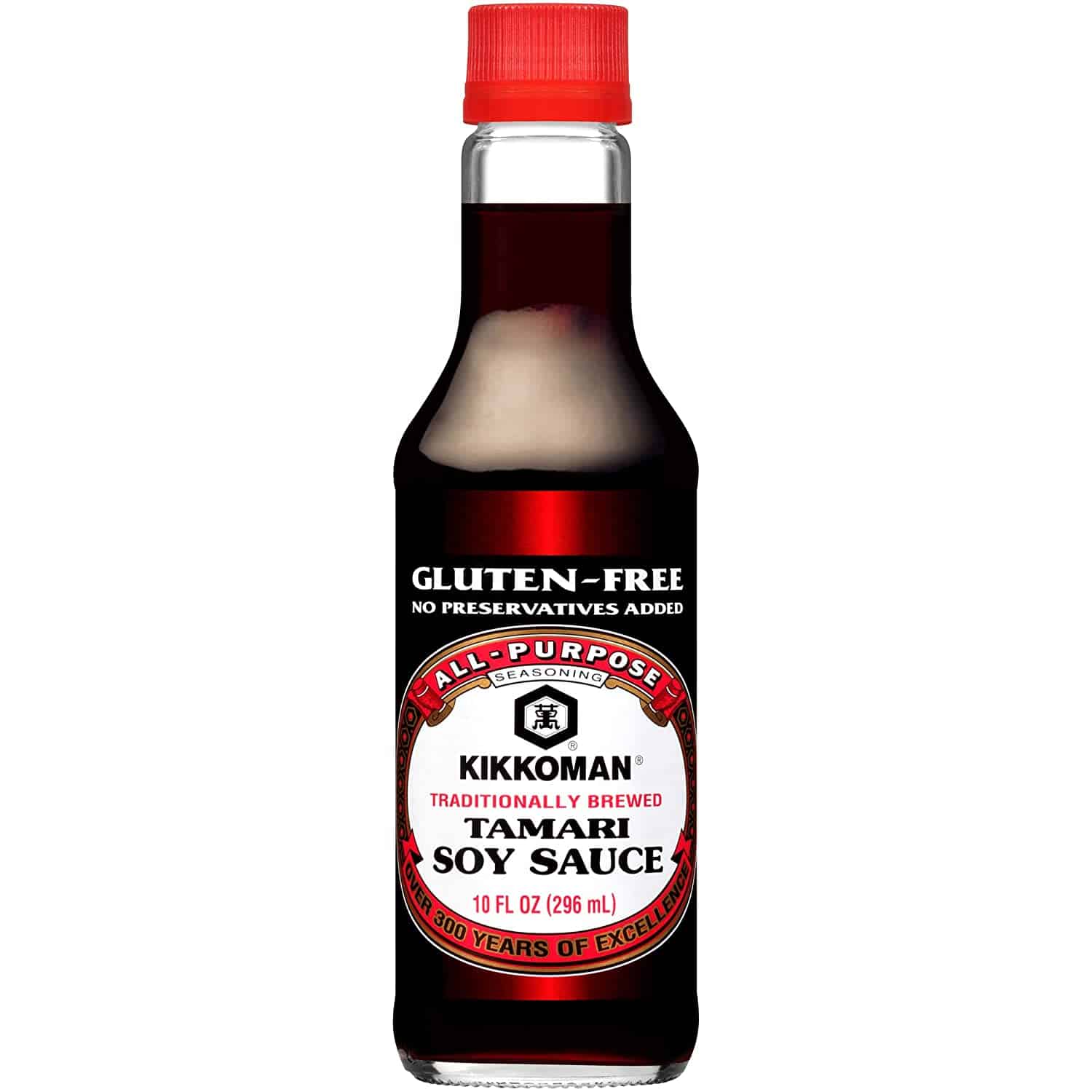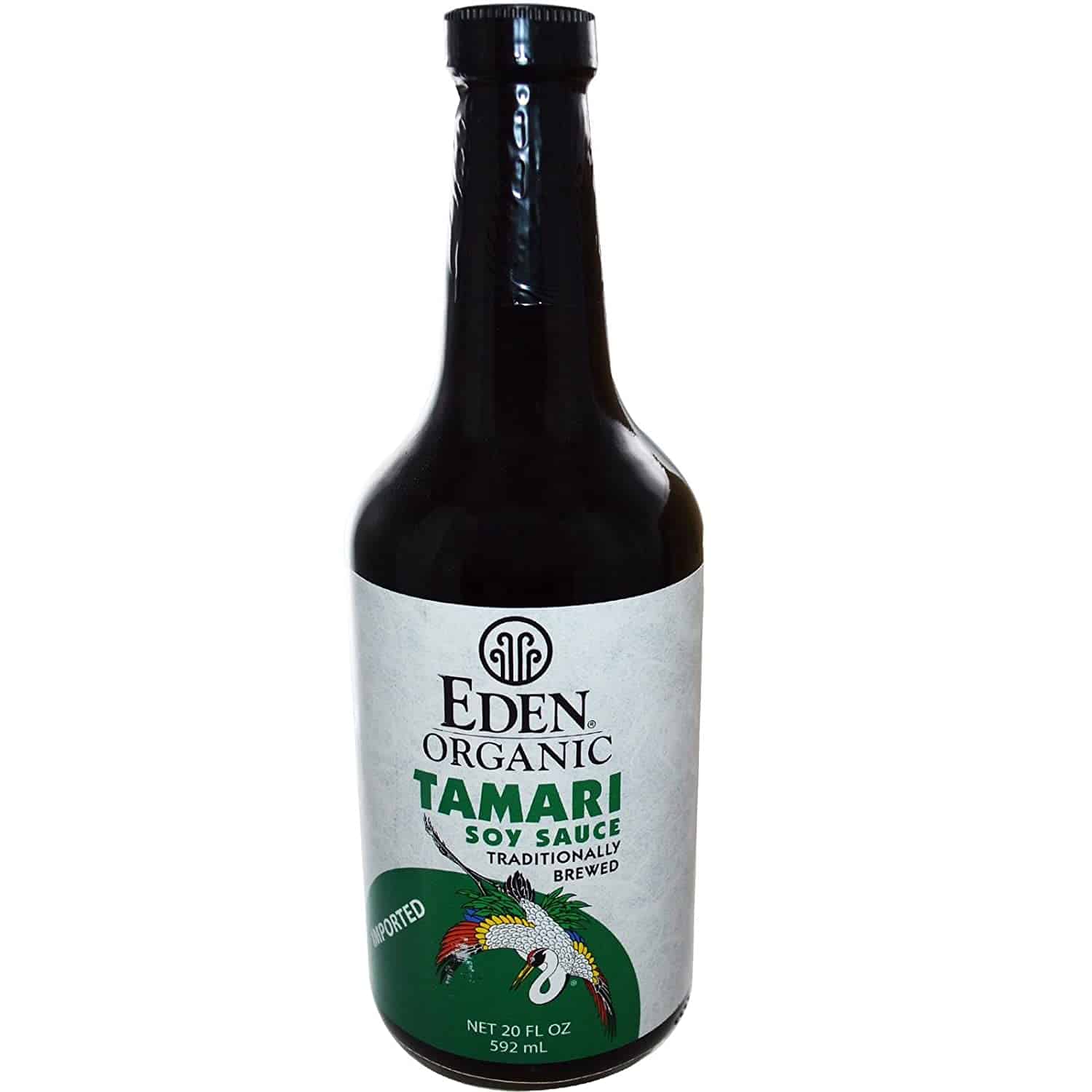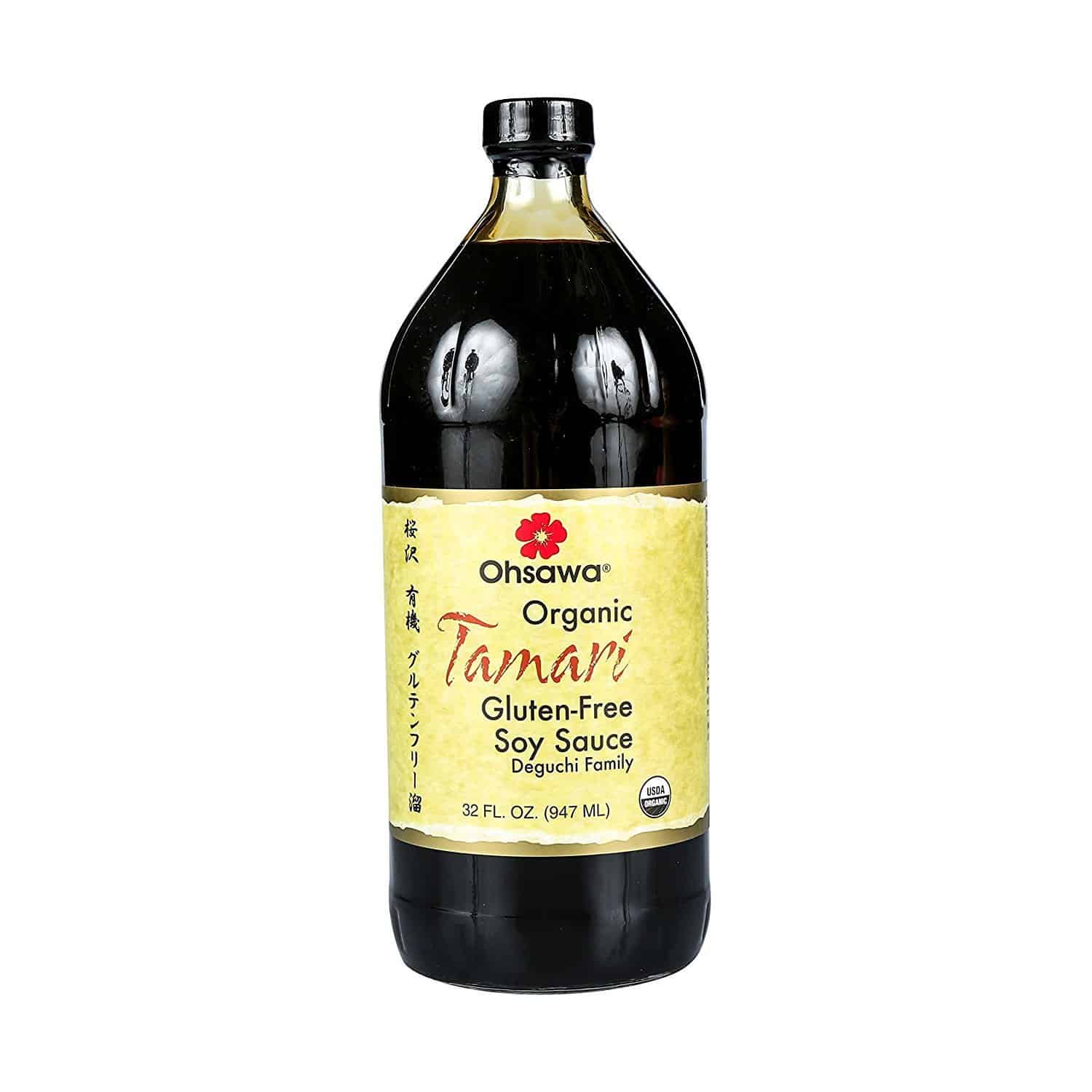Best Tamari Sauce | Top 6 Gluten Free Shoyu Soy Sauce Reviewed
Although tamari can cost more than soy sauce, it delivers great flavor, especially when used in Japanese-inspired recipes. Plus it’s gluten-free made without wheat!
My favorite is this San-J tamari sauce. An affordable but pure product that contains no artificial preservatives or MSG. Instead of using wheat, it’s brewed with soybeans and salt. The tamari has a deep taste that’s perfect for enhancing the flavor of your food.
In this guide, I’ll walk you through the top 6 choices, whether you’re making stir-fry, dipping sauce, soup, or marinating some meats and seafood for a Japanese BBQ.
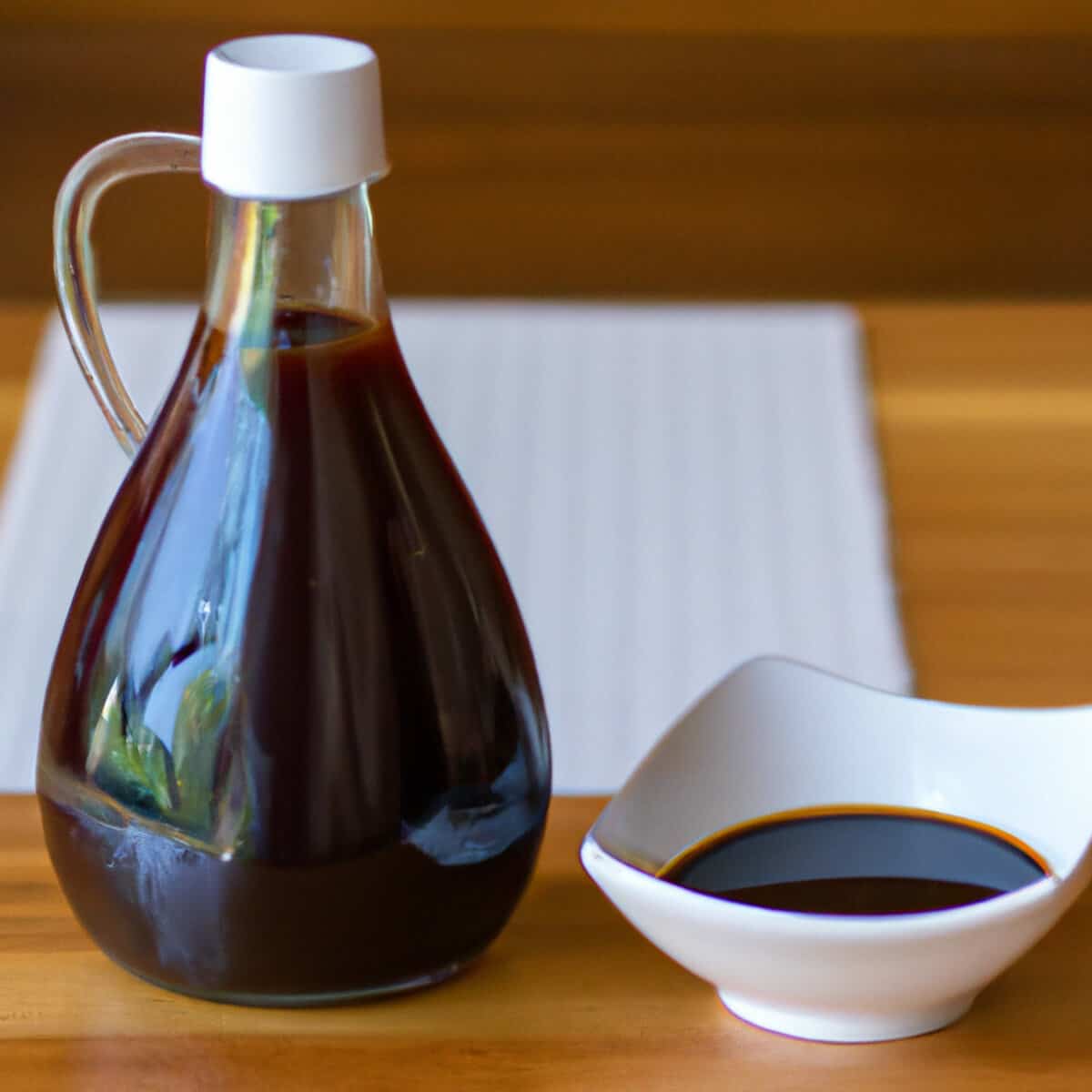
Here’s a preview of the 6 best tamari sauces you can buy. Detailed reviews are down below!
Best overall
When looking for the perfect tamari sauce you can use for rice, stir-fry, stew, soup, and even dipping sauce, you should go for a full-bodied tamari.
Best low-sodium
If you’re watching your sodium intake, choose a low-sodium option like this one from San-J.
Best budget choice
Kikkoman is an affordable brand, so this tamari sauce is great for those looking to spend less but still want a tasty and rich umami tamari sauce.
Best organic & best for dipping sushi
If you’re looking for an authentic, healthy tamari shoyu, this one is excellent because it’s organic and healthier than some of the others.
Best premium
Although this tamari is pricy, it’s a pure soybean tamari that tastes so pure you’ll notice the difference between Ohsawa and the cheaper tamari sauces out there.
Best flavored tamari & best for glazing meat and seafood
This Haku tamari is infused with black truffles, giving it a unique taste that’s sure to please the palate.

Check out our new cookbook
Bitemybun's family recipes with complete meal planner and recipe guide.
Try it out for free with Kindle Unlimited:
Read for freeIn this post we'll cover:
- 1 Tamari sauce buying guide
- 2 Best brands of tamari shoyu reviewed
- 2.1 Best overall: San-JTamari Soy Sauce
- 2.2 Best low-sodium: San-J Gluten Free Tamari Soy Sauce Reduced Sodium
- 2.3 Best budget choice: KikkomanGluten Free Tamari Soy Sauce
- 2.4 Best organic & best for dipping sushi: Eden Foods Organic Tamari Soy Sauce
- 2.5 Best premium: Ohsawa Organic Wheat-Free Tamari Soy Sauce
- 2.6 Best flavored tamari & best for glazing meat and seafood: Haku Black Truffle Tamari
- 3 What does tamari taste like?
- 4 How do you use tamari sauce in cooking?
- 5 Does tamari sauce have to be refrigerated?
- 6 FAQs
- 7 Takeaway
Tamari sauce buying guide
When you’re looking for the best tamari sauce, there are several things you should keep in mind.
Use: what do you want to use it for?
First, consider what you’ll be using the tamari for.
Some versions are better suited to dipping, while others have a more intense flavor that’s ideal for cooking.
If you’re not sure, go for a versatile option that can be used for both. Just remember that the darker and more intense the tamari, the less you’ll need to use.
Brand
Check the brand too. San-J and Kikkoman are well-known popular Japanese brands that make high-quality tamari.
But there are some smaller breweries that produce excellent tamari as well, although it’s usually a premium tamari and more expensive.
Ingredients: is it organic or gluten-free?
Next, check the ingredient list to make sure the product is gluten-free.
Although tamari is typically made without wheat, some manufacturers add it in, so it’s always best to double-check.
You can also look to see if the tamari is organic and non-GMO.
These versions are usually more expensive but may be worth the extra cost if you’re looking for a healthier product.
Flavor: light, dark, or in between?
Finally, think about the flavor you want. The darker the tamari, the more intense the taste will be.
If you’re new to tamari, start with a light version and work your way up to the darker, more intense tamaris.
It’s kind of like choosing soy sauce, you can try to see what flavors you like best. There are also some flavored tamari sauces, like the truffle-flavored tamari shoyu by Haku.
These additional ingredients can give the sauce a more complex flavor profile.
Barrel aging
One thing to note is that some tamaris are barrel-aged while others are not. This process can add a deeper, richer flavor to the tamari.
However, it’s not necessary, and some people prefer the more straightforward taste of non-barrel-aged tamari. It’s really up to you and what you prefer.
Barrel-aged tamari sauce can be more expensive than non-barrel-aged tamari, but the difference in price is usually not significant.
Sodium-content
Finally, take a look at the sodium content. Some tamari sauces can be quite high in salt, so if you’re watching your sodium intake, choose a low-sodium option.
Now that you know what to look for, here are some of the best tamari sauces on the market.
Also read: Miso vs soy sauce | Taste, uses, and nutrition differences explained
Best brands of tamari shoyu reviewed
We’ve rounded up the best tamari sauces here, so you can choose one based on your dietary and flavor preferences.
Best overall: San-JTamari Soy Sauce
When looking for the perfect tamari sauce you can use for rice, stir-fry, stew, soup, and even dipping sauce, you should go for a full-bodied tamari.
Choosing a flavorful tamari sauce is going to make the difference when you’re using it as a marinade or dipping sauce.
The best brands of tamari deliver on taste without being overly salty.
As one of the most popular tamari brands, San-J produces high-quality, gluten-free tamari that’s perfect for cooking or dipping.
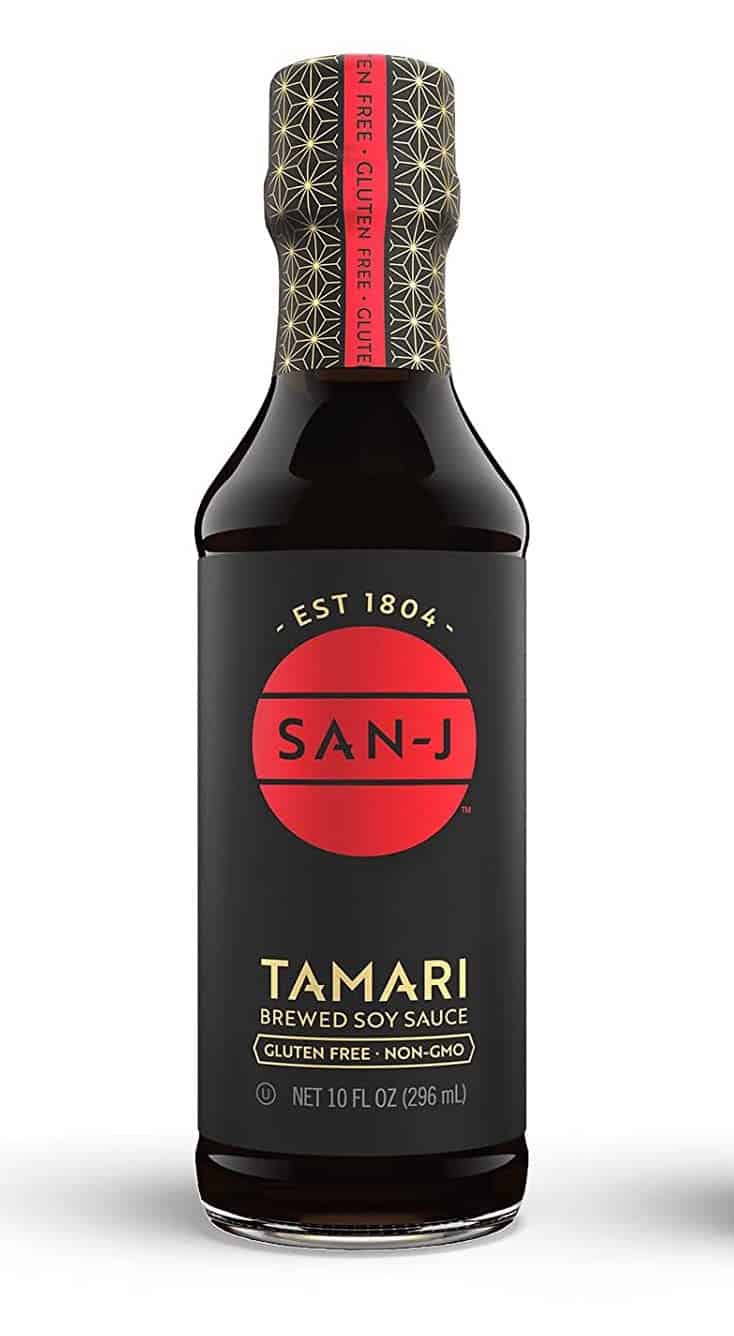
The tamari sauce isn’t super salty, so you can actually taste the delicate flavors of your food.
The San-J is rich, flavorful, and has the perfect umami taste that will greatly enhance the flavor of your food.
Since the taste is just the right amount of umami, it’s a great dipping sauce for sushi and sashimi.
It can also be added to any saucéd dishes like stir-fry or used as a marinade for meats and seafood.
It’s also a gluten-free product that’s brewed without wheat and contains no artificial preservatives or MSG.
The tamari is made with soybeans and salt, which gives it its delicious pure taste.
People are using this tamari as a soy sauce substitute in teriyaki sauce and marinade for meat because it’s gluten-free and has a pure umami taste.
It’s a full-bodied sauce without that overwhelming saltiness.
If you’re new to tamari, this is a great place to start, as it has a light but flavorful taste that won’t be too overpowering.
You can use it as a marinade, dipping sauce, or in any recipe that calls for soy sauce.
Check out the latest prices here
Best low-sodium: San-J Gluten Free Tamari Soy Sauce Reduced Sodium
The San-J gluten-free tamari with reduced sodium contains 28% less salt than the regular San-J tamari sauce I mentioned above.
Thus, it is recommended for those on a low-sodium diet.

As we mentioned before, some tamari sauces can be quite high in salt. If you’re watching your sodium intake, choose a low-sodium option like this one from San-J.
But don’t worry, less sodium doesn’t mean the tamari sauce is flavorless or any less tasty.
In fact, even chefs love the taste of this tamari – it’s just as flavorful as the regular version but with 28% less sodium.
It has the same bold, rich, umami taste as the regular San-J tamari, and the color is the same too.
Some home cooks are saying this low-sodium version of the tamari has a flavor that is very similar to regular low-sodium soy sauce, you can barely tell the difference.
The San-J reduced salt tamari is also gluten-free, non-GMO, vegan, kosher, Fodmap friendly. If you’re on a low-sodium diet, this is the best tamari sauce for you.
Best budget choice: KikkomanGluten Free Tamari Soy Sauce
Kikkoman is a leader in bringing Japanese food products to the United States. When it comes to taste, they’re sure to deliver that umami flavor you’re looking for!
This tamari sauce is excellent for cooking – you can use it to flavor rice dishes, noodles, soups, and stir-fries or add it to your marinades and sauces.
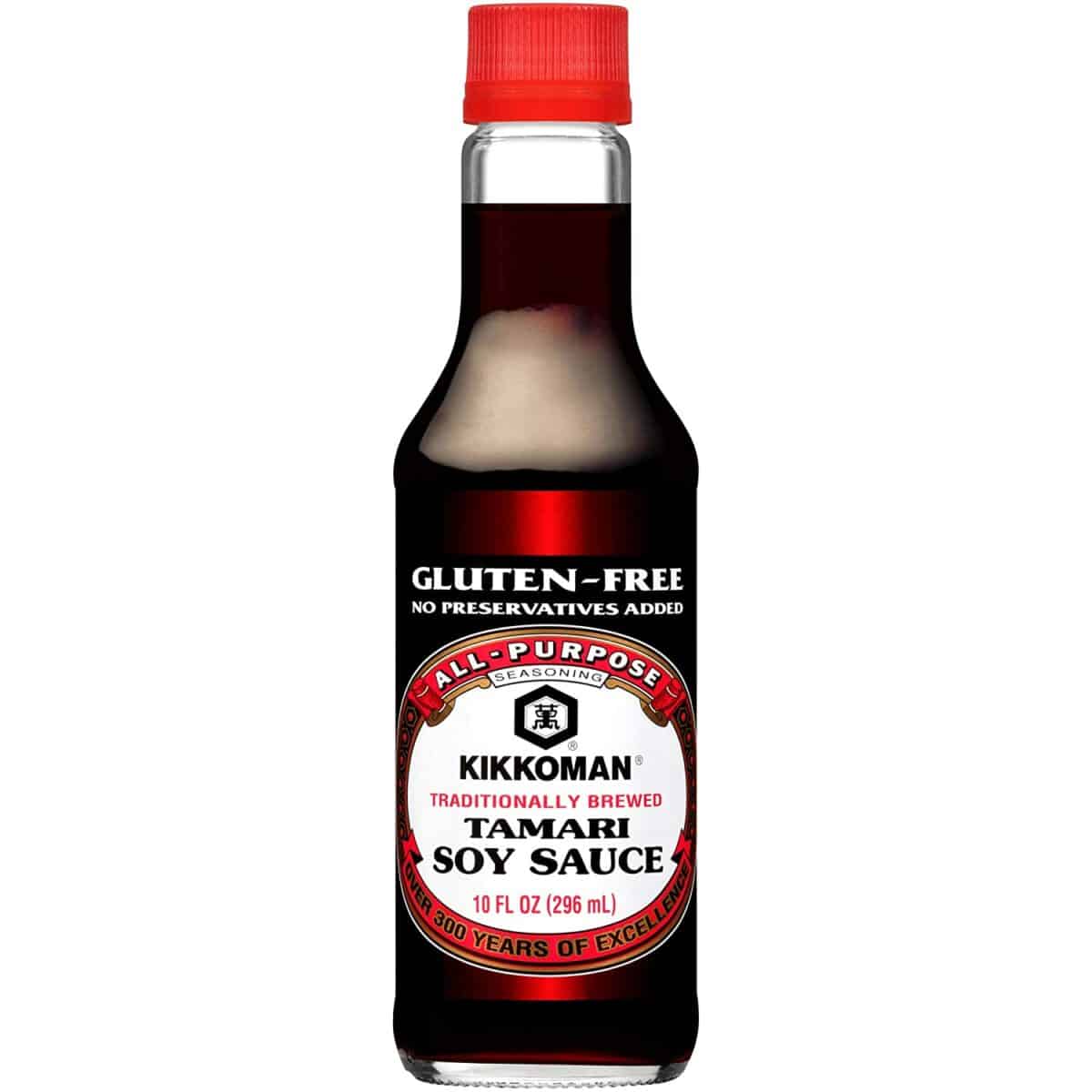
Most people appreciate the fact that this tamari has a very similar flavor to regular Kikkoman soy sauce.
The truth is, many people agree that you can’t really tell the difference between this GF version and the regular Kikkoman soy sauce.
That’s because they use the same high-quality ingredients and brewing process.
The only difference is that this Kikkoman tamari is brewed without wheat, making it gluten-free.
Kikkoman is an affordable brand, so this tamari sauce is great for those looking to spend less but still want a tasty and rich umami tamari sauce.
Compared to the San-J, the flavor is a bit diluted, so it’s better for cooking, whereas San-J has a pure flavor that works great as a dipping sauce for seafood dishes like sushi.
Best organic & best for dipping sushi: Eden Foods Organic Tamari Soy Sauce
Eden Foods is a quality brand known for manufacturing foods that promote healthy eating. They make a great replacement for traditional Japanese soy sauce in Asian cuisine.
If you’re looking for an authentic, healthy tamari shoyu, this one is excellent because it’s organic and healthier than some of the others.
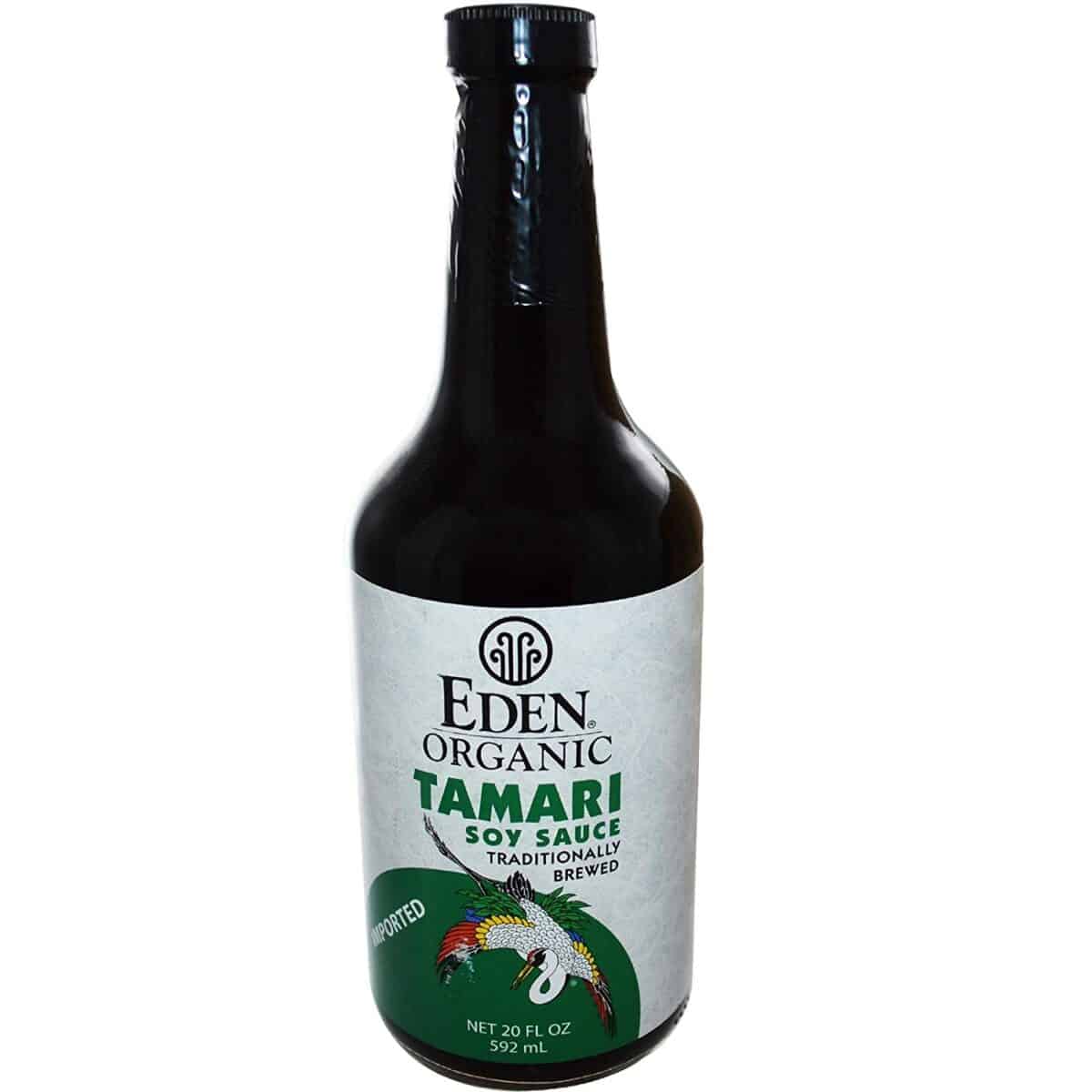
There are many tamari sauces out there, but according to many customers, this one has the best, richest, and most complex flavor because it was aged for a long time in wooden barrels, which is the traditional Japanese method.
Additionally, it’s organic. This means it’s made without the use of synthetic pesticides, herbicides, or fertilizers.
The only downside to this tamari is that it’s more expensive than some of the other brands. But if you’re looking for a healthier option, it’s worth the extra money.
Since it’s such a bold, umami-flavored tamari, it makes for an excellent sushi dipping sauce.
When you’re eating sushi and sashimi, you want a tamari that can stand up to the fishiness of the raw fish, and this one does that perfectly.
Many people also combine this organic tamari with mirin to create a perfect sweet and savory noodle and soup base.
The Ohsawa brand is known for providing macrobiotic food, as well as hard-to-find organics and heirloom quality grains, beans, and seeds.
Theirs is reported to be a tamari soy sauce unlike any you’ve ever tasted!
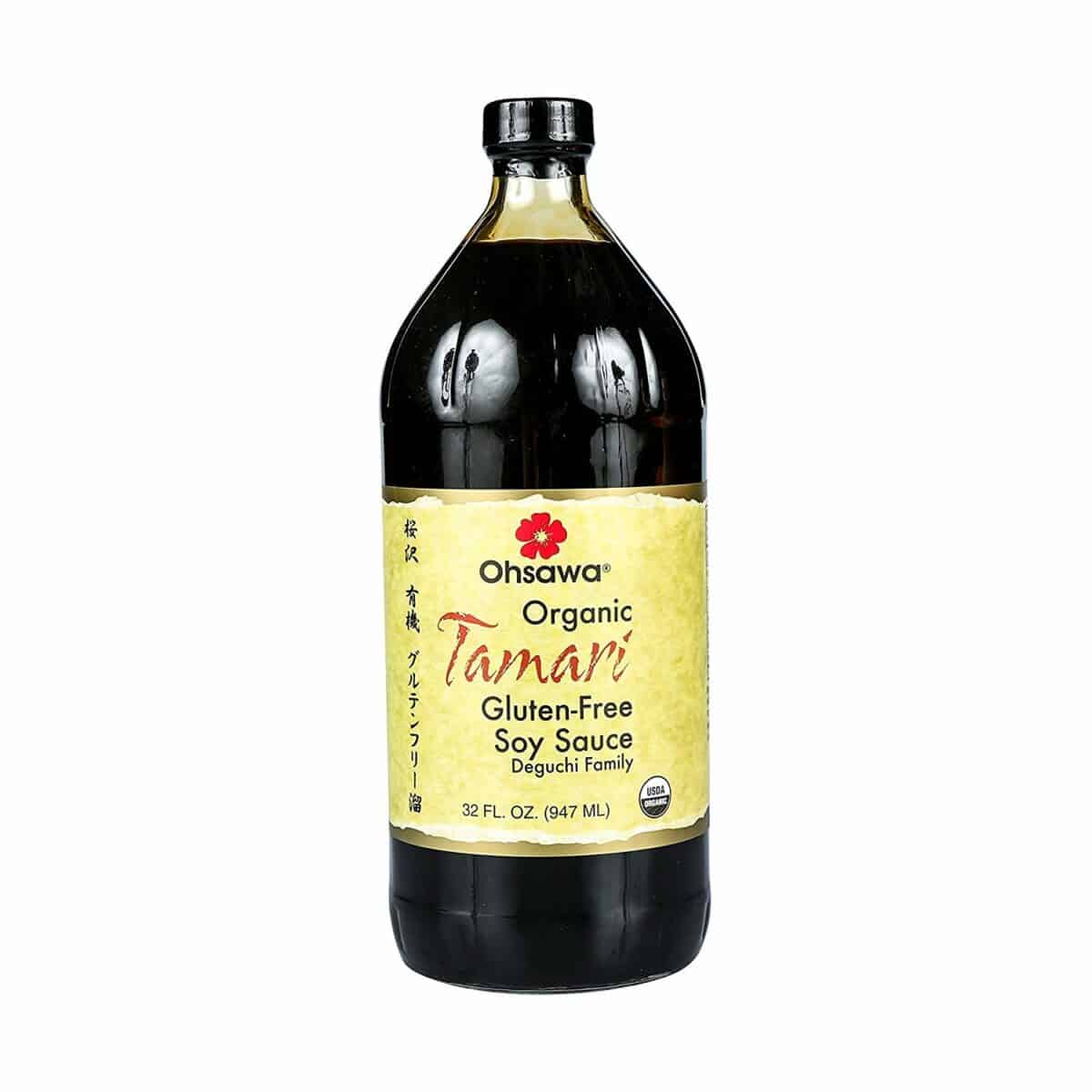
Although this tamari is pricy, it’s a pure soybean tamari that tastes so pure you’ll notice the difference between Ohsawa and the cheaper tamari sauces out there.
When compared to shoyu, Ohsawa Tamari has a deeper color, a richer consistency, and a more intricate fragrance, which helps it keep its flavor longer during cooking.
Therefore I recommend it for stews and meat marinades where other tamaris tend to become overly diluted.
This sauce has a deeper and softer flavor than ordinary soy sauce and is gluten-free.
Ohsawa Tamari’s deep, delicious flavor compliments any kind of food, and this is possible because of the traditional Japanese fermentation technique.
Those who know their soy sauce, especially chefs, love to use this premium tamari as a dipping sauce, marinade, and for stir-frying.
You can add it to sauces, casseroles, salads, and soups.
But don’t forget that a little Tamari goes a long way in marinades, vegetable dishes, stews, sauces, and salad dressings because it is robust and savory.
Best flavored tamari & best for glazing meat and seafood: Haku Black Truffle Tamari
If you’re looking for an extra flavorful tamari, look no further than Haku. Theirs is infused with black truffles, giving it a unique taste that’s sure to please the palate.
This tamari is barrel-aged and made with top-quality Japanese soybeans. Therefore, it’s a similar product to Ohsawa and Eden foods tamari.
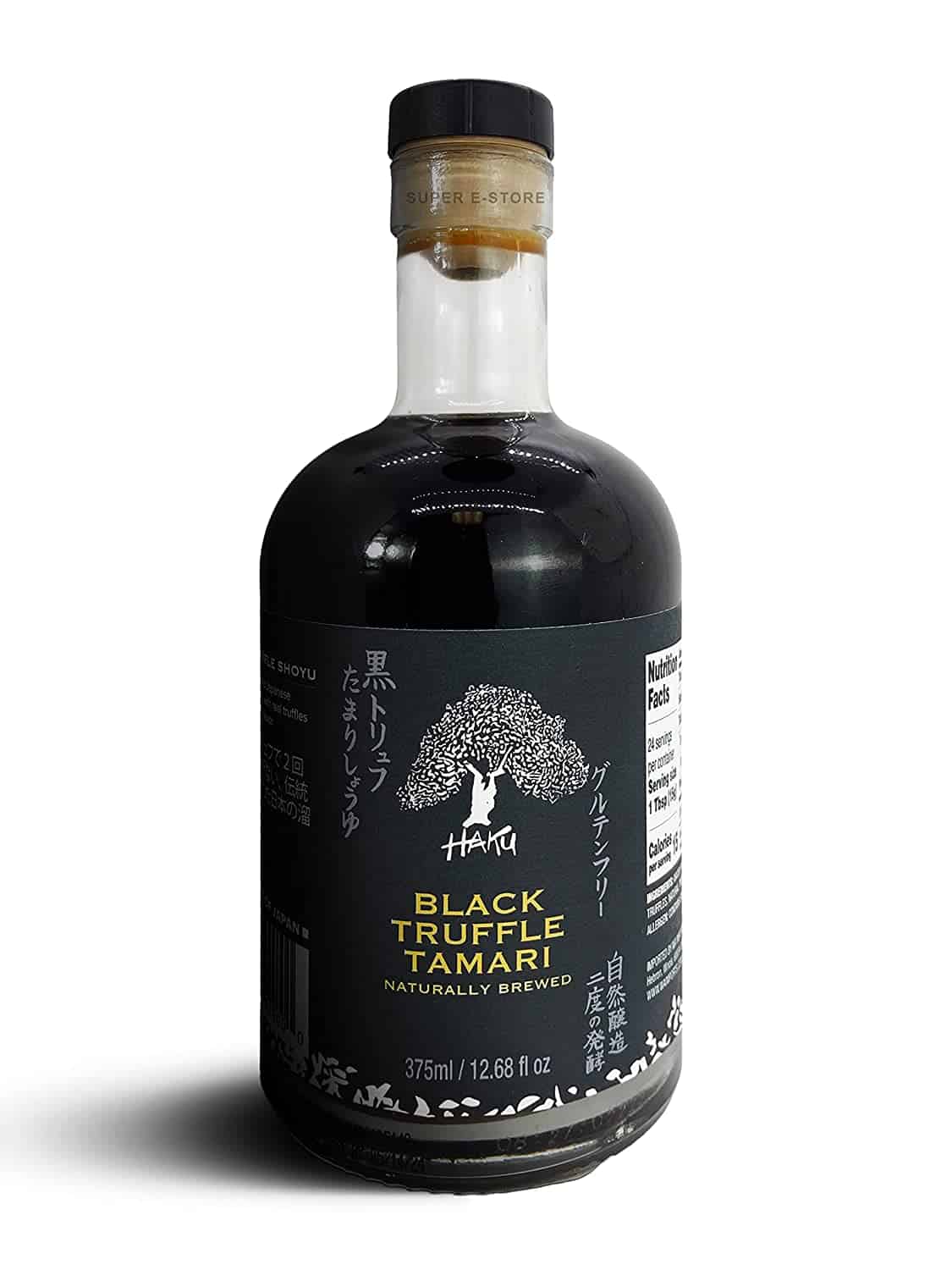
The black truffle flavor is not too overwhelming, but it’s definitely there and enhances the taste.
The addition of truffles gives this tamari a rich, earthy, and savory flavor. Therefore, it’s a great addition to meat and seafood.
I recommend using a truffle-flavored tamari as a glaze for meats and seafood before cooking.
It’s also a great dipping sauce for sushi and sashimi because the truffle flavor can stand up to the fishiness of the raw fish.
Many people also use it as a finishing sauce for noodles, dumplings, tofu, and rice dishes. This tamari really adds more umami and makes your dishes taste more decadent.
The truffles give this tamari a bit of an earthy, pungent scent, so maybe it’s not the best dipping sauce for some, but many people like to dip their fried foods like eggrolls into it.
So, if you like truffles, this is a delicacy to have in your pantry! It will last a long time, too, since a little goes a long way.
What does tamari taste like?
Tamari is a type of dark-colored soy sauce that has a rich, savory, and umami flavor. There’s a slight sweetness to it, but it’s also less salty tasting than regular soy sauce.
Since it’s gluten-free and made without wheat (in most cases), tamari has a slightly different flavor than soy sauce. But it’s still best described as umami.
The flavored tamari sauces will have their own unique flavor profiles, depending on what they’re infused with. For example, the truffle tamari will taste earthy and savory.
Organic tamari may taste purer and less processed than non-organic tamari.
How do you use tamari sauce in cooking?
Tamari sauce is a great all-purpose seasoning and can be used in many different ways. In most cases, tamari and soy sauce are used interchangeably.
Therefore, you can use the tamari sauce just like you would regular soy sauce.
Here are some ideas:
- Use it as a dipping sauce for sushi, sashimi, egg rolls, spring rolls, and dumplings.
- Use it as a marinade for meats, poultry, and seafood.
- Add it to soups, stews, and sauces for extra flavor.
- Use it as a glaze for meats and seafood before cooking.
- Add it to stir-fries, noodle dishes, and rice dishes.
- Use it as a finishing sauce for noodles, dumplings, tofu, and rice dishes.
- Use it in salad dressings.
The possibilities are endless, and you can use tamari in Asian or Western dishes as long as you’re looking for that classic umami taste.
Try making this Tangy Tamari Soy Sauce Dressing (Easy 5-Min Recipe)
Does tamari sauce have to be refrigerated?
No, tamari sauce does not have to be refrigerated. In fact, it can last for months or even years if it’s stored in a cool, dark place.
The only exception is if you open a bottle of tamari and don’t finish it within a few months. In that case, it’s best to refrigerate it to prevent the tamari from going bad.
FAQs
What’s the difference between tamari and soy sauce?
Tamari is a type of dark-colored soy sauce that has a rich, savory, and umami flavor. There’s a slight sweetness to it, but it’s also less salty tasting than regular soy sauce.
Also, tamari doesn’t contain wheat, so it’s gluten-free. On the other hand, soy sauce is made with wheat, and therefore, it contains gluten.
What is the best substitute for tamari?
If you’re not concerned about gluten, regular soy sauce is the best substitute for tamari. Otherwise, you can use coconut aminos or liquid aminos as a gluten-free alternative.
Can I use tamari instead of salt?
Yes, you can use tamari as a salt substitute. Just keep in mind that it is quite salty, so use it sparingly.
Is tamari healthier than soy sauce?
There’s no definitive answer to this question since it depends on your definition of “healthy.”
However, tamari is generally considered to be healthier than soy sauce because it’s less processed and doesn’t contain wheat. Some brands also make low-sodium tamari which is a bit healthier.
Does all tamari sauce have gluten?
No, not all tamari sauce has gluten. In fact, most brands make gluten-free tamari. However, there are some brands that add wheat to their tamari, so always check the label to be sure.
Is tamari vegan?
Yes, tamari is vegan. It’s made with soybeans, salt, and water. Some brands also add alcohol or other ingredients, but the vast majority of tamari is vegan.
Where can I buy tamari sauce?
Tamari sauce is widely available in the Asian section of most supermarkets. You can also find it online or at specialty stores.
Takeaway
Tamari sauce is a dark-colored, rich, and savory sauce that’s made with soybeans, salt, and water. It doesn’t contain wheat, so it’s gluten-free.
Tamari is a great all-purpose seasoning and can be used in many different ways.
My favorite is the San-J tamari sauce because it can be used to make any type of dish, and it has a distinct umami flavor.
If you like premium tamari, you can really notice subtle flavor nuances, especially when you use it as a dipping sauce.
The best premium tamari has a deep, dark color and a complex flavor that’s both savory and slightly sweet.
So, get out there and try some tamari to see which one you prefer!
Tamari is of course a great substitute for regular soy sauce (but not the only one!)
Check out our new cookbook
Bitemybun's family recipes with complete meal planner and recipe guide.
Try it out for free with Kindle Unlimited:
Read for freeJoost Nusselder, the founder of Bite My Bun is a content marketer, dad and loves trying out new food with Japanese food at the heart of his passion, and together with his team he's been creating in-depth blog articles since 2016 to help loyal readers with recipes and cooking tips.

